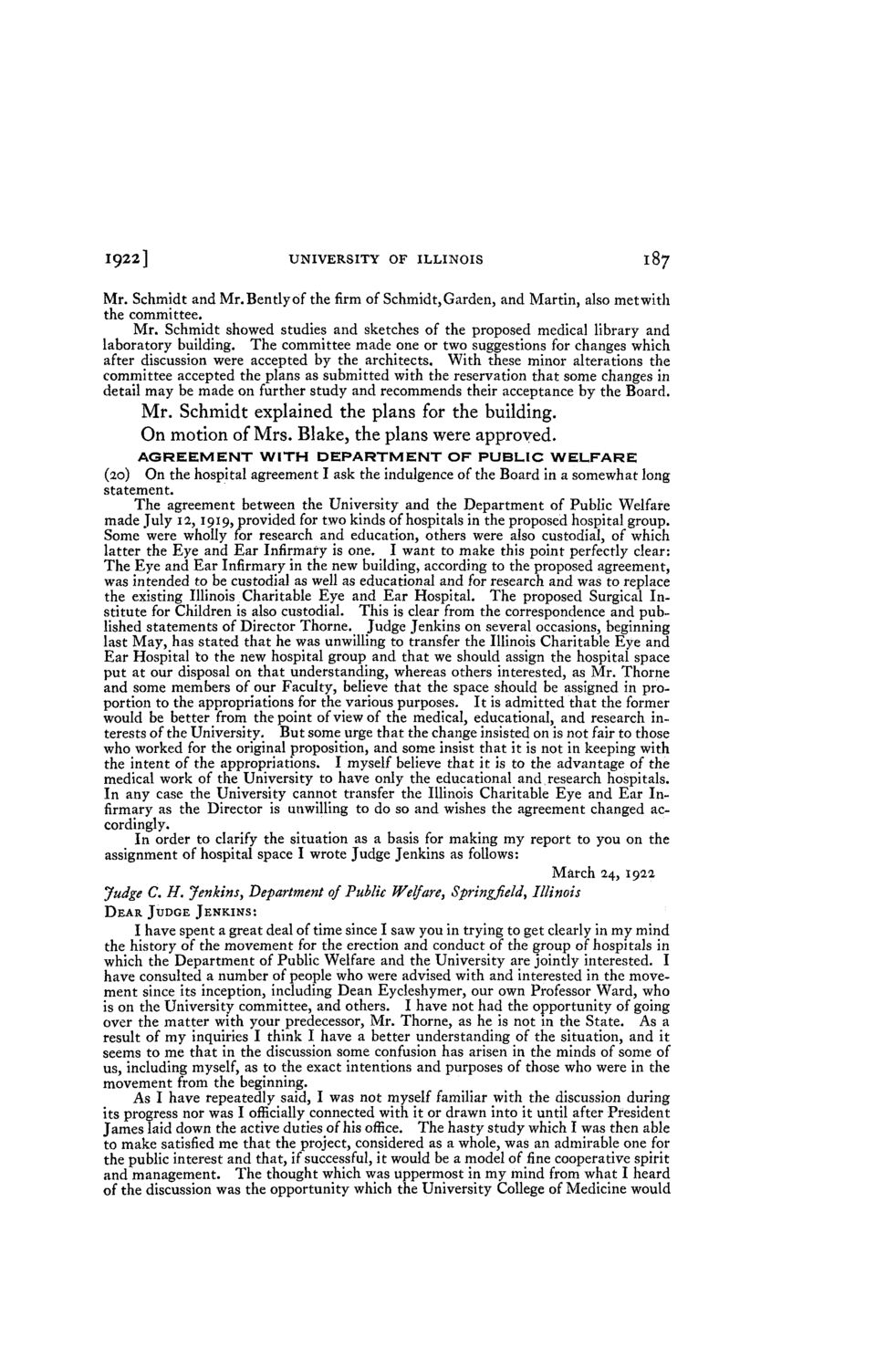| |
| |
Caption: Board of Trustees Minutes - 1922
This is a reduced-resolution page image for fast online browsing.

EXTRACTED TEXT FROM PAGE:
1922] UNIVERSITY OF ILLINOIS 187 Mr. Schmidt and Mr. Bendy of the firm of Schmidt, Garden, and Martin, also met with the committee. Mr. Schmidt showed studies and sketches of the proposed medical library and laboratory building. The committee made one or two suggestions for changes which after discussion were accepted by the architects. With these minor alterations the committee accepted the plans as submitted with the reservation that some changes in detail may be made on further study and recommends their acceptance by the Board. Mr. Schmidt explained the plans for the building. On motion of Mrs. Blake, the plans were approved. A G R E E M E N T WITH D E P A R T M E N T OF PUBLIC WELFARE (20) On the hospital agreement I ask the indulgence of the Board in a somewhat long statement. The agreement between the University and the Department of Public Welfare made July 12,1919, provided for two kinds of hospitals in the proposed hospital group. Some were wholly for research and education, others were also custodial, of which latter the Eye and Ear Infirmary is one. I want to make this point perfectly clear: The Eye and Ear Infirmary in the new building, according to the proposed agreement, was intended to be custodial as well as educational and for research and was to replace the existing Illinois Charitable Eye and Ear Hospital. The proposed Surgical Institute for Children is also custodial. This is clear from the correspondence and published statements of Director Thorne. Judge Jenkins on several occasions, beginning last May, has stated that he was unwilling to transfer the Illinois Charitable Eye and Ear Hospital to the new hospital group and that we should assign the hospital space put at our disposal on that understanding, whereas others interested, as Mr. Thorne and some members of our Faculty, believe that the space should be assigned in proportion to the appropriations for the various purposes. It is admitted that the former would be better from the point of view of the medical, educational, and research interests of the University. But some urge that the change insisted on is not fair to those who worked for the original proposition, and some insist that it is not in keeping with the intent of the appropriations. I myself believe that it is to the advantage of the medical work of the University to have only the educational and research hospitals. In any case the University cannot transfer the Illinois Charitable Eye and Ear Infirmary as the Director is unwilling to do so and wishes the agreement changed accordingly. In order to clarify the situation as a basis for making my report to you on the assignment of hospital space I wrote Judge Jenkins as follows: March 24, 1922 Judge C. H. Jenkins, Department of Public Welfare, Springfield, Illinois DEAR JUDGE JENKINS: I have spent a great deal of time since I saw you in trying to get clearly in my mind the history of the movement for the erection and conduct of the group of hospitals in which the Department of Public Welfare and the University are jointly interested. I have consulted a number of people who were advised with and interested in the movement since its inception, including Dean Eycleshymer, our own Professor Ward, who is on the University committee, and others. I have not had the opportunity of going over the matter with your predecessor, Mr. Thorne, as he is not in the State. As a result of my inquiries I think I have a better understanding of the situation, and it seems to me that in the discussion some confusion has arisen in the minds of some of us, including myself, as to the exact intentions and purposes of those who were in the movement from the beginning. As I have repeatedly said, I was not myself familiar with the discussion during its progress nor was I officially connected with it or drawn into it until after President James laid down the active duties of his office. The hasty study which I was then able to make satisfied me that the project, considered as a whole, was an admirable one for the public interest and that, if successful, it would be a model of fine cooperative spirit and management. The thought which was uppermost in my mind from what I heard of the discussion was the opportunity which the University College of Medicine would
| |